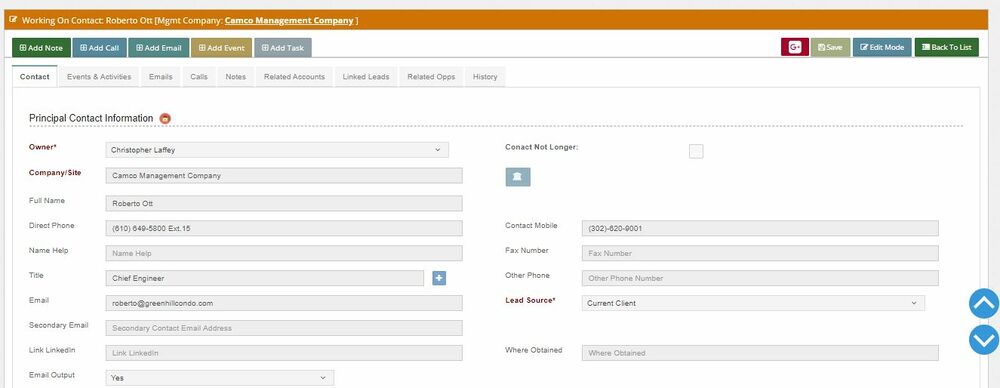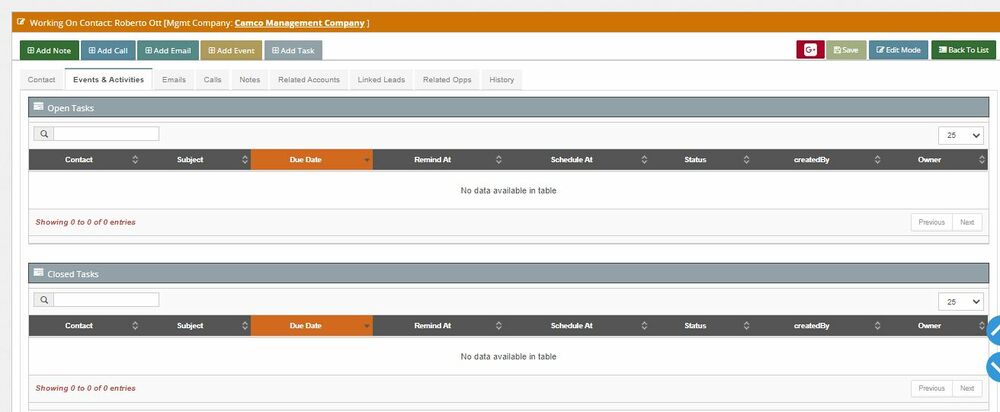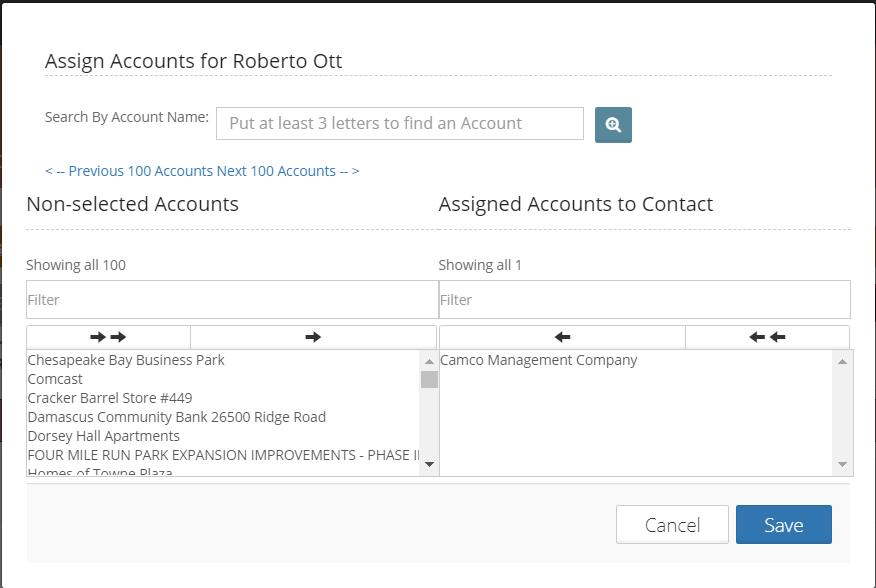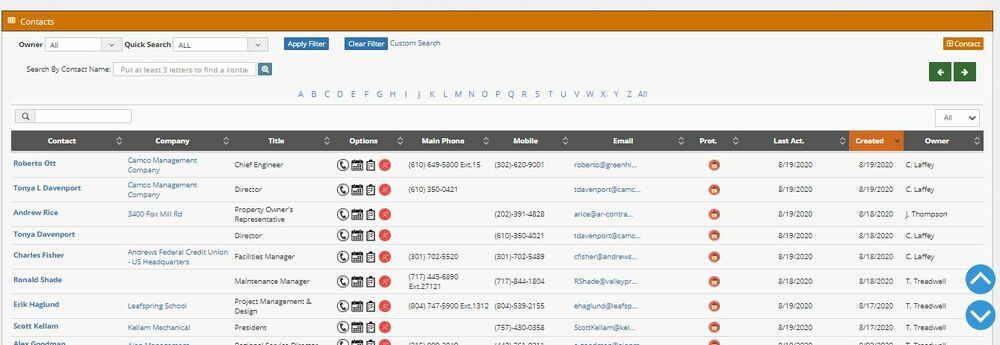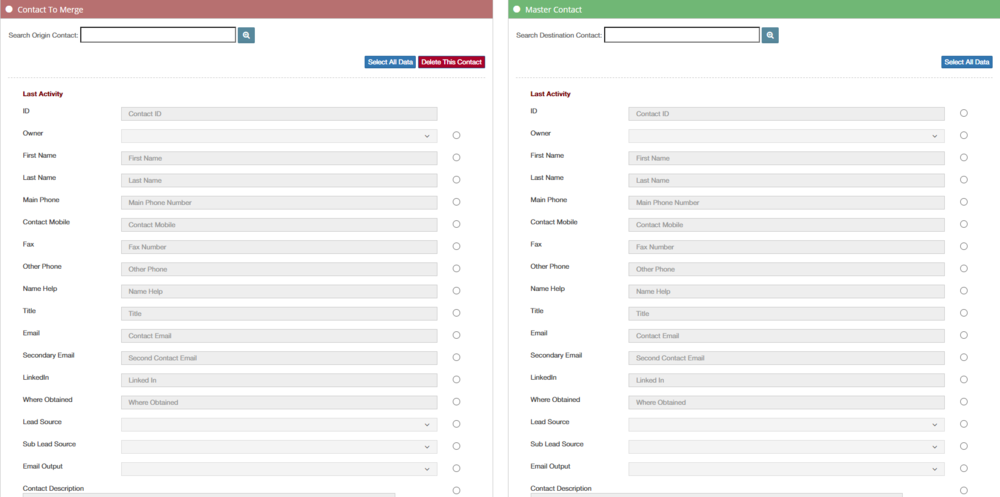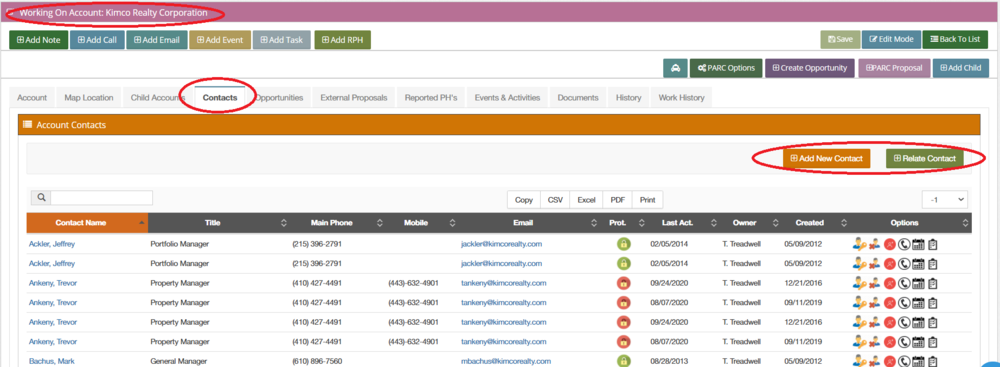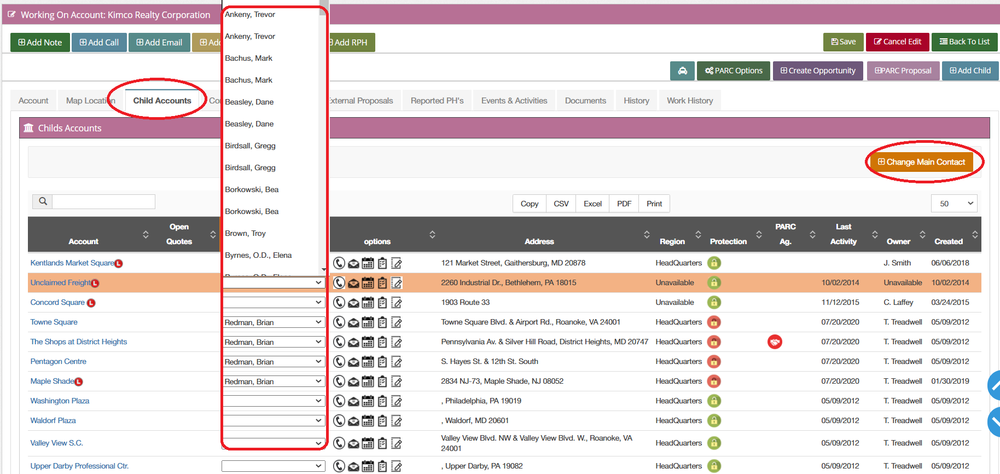Difference between revisions of "Contacts"
| Line 13: | Line 13: | ||
* Automatically created by the System: Once an opportunity is created for a Lead and closed as won, the system automatically converts the Lead into an Account and saves the Contact in the database for future re-use. | * Automatically created by the System: Once an opportunity is created for a Lead and closed as won, the system automatically converts the Lead into an Account and saves the Contact in the database for future re-use. | ||
| − | + | ''Note: When creating a new contact from the Account Module, the system will auto-populate all previously recorded information related to that specific account.'' | |
=New Contact Form= | =New Contact Form= | ||
| Line 218: | Line 218: | ||
[[File:604.jpg|1000px|center|thumb]] | [[File:604.jpg|1000px|center|thumb]] | ||
| − | Once the filtering is done, the system will show the results in a list. The user can search among the results using the | + | Once the filtering is done, the system will show the results in a list. The user can search among the results using the ''Search'' field (magnifying glass); the system will refine the results to display matches with any field of the shown results. |
On the above bar at the top right, there is a button that works as a shortcut: | On the above bar at the top right, there is a button that works as a shortcut: | ||
| − | + | ''+Contact'': quick Contact creation form access | |
The results can be extracted and downloaded to the local disk in different formats such as CSV, Excel, PDF, or directly printed or copied to the clipboard. | The results can be extracted and downloaded to the local disk in different formats such as CSV, Excel, PDF, or directly printed or copied to the clipboard. | ||
| Line 321: | Line 321: | ||
==Contact Protection== | ==Contact Protection== | ||
| − | Even though explained earlier, it is important to re-iterate that | + | Even though explained earlier, it is important to re-iterate that '''what is protected is not the site, but the human.''' |
For example: Consider a company like Kimco having hundreds of employees and thousands of properties they manage. It would be considerably challenging for one account manager to cover all Kimco's properties while developing a relationship with all their employees. | For example: Consider a company like Kimco having hundreds of employees and thousands of properties they manage. It would be considerably challenging for one account manager to cover all Kimco's properties while developing a relationship with all their employees. | ||
Latest revision as of 15:52, 15 April 2021
What is a contact?
Let's revisit a concept we touched on earlier in this manual: the 3-dimensional dataset and the triangle consisting of the specific site, the human, and the property management.
When we talk about Contacts, we refer to the vast information related to the human beings that manage specific sites and work for particular companies. And those two roles are quite distinct: the company they work for is not typically the same company that manages the property.
How to create a Contact
The two most common ways of creating a contact are detailed below:
- Manually using the "New Contact" form: Users create the contact manually through the bar menu in the CRM
- Automatically created by the System: Once an opportunity is created for a Lead and closed as won, the system automatically converts the Lead into an Account and saves the Contact in the database for future re-use.
Note: When creating a new contact from the Account Module, the system will auto-populate all previously recorded information related to that specific account.
New Contact Form
The user can find contact information in tabs containing different data types, unique for each Contact.
These Tabs are:
- Contact
- Events & Activities
- Emails
- Calls
- Notes
- Related Accounts
- Linked Leads
- Related Opps
- History
Contact
This tab contains basic information about the Contact, separated into subsections for better sorting. Please note that this is the same information to be filled in the "New Contact Form" when creating a new Contact.
Principal Contact Information
- Owner
- Contact Not Longer
- Company/Site
- Full Name
- Direct Phone
- Contact Mobile
- Name Help
- Fax Number
- Title
- Other Phone
- Lead Source
- Secondary Email
- Link LinkedIn
- Where Obtained
- Email Output
Contact Description
Description: This tab contains a free text box for contact description
Address Information
- State
- City
- Street
- Suite
- Apartment
- Bill BOX
- Electronic Bill Mail
- Special Billing Instructions
Events & Activities
This tab shows the Tasks or events created related to the Contact.
For further information please visit the Events and Task page.
Emails
This tab contains a record of all emails exchanged with the contact. Emails will appear sorted within these columns:
- Subject
- From
- To
- Created (date)
There is also a search bar on the top left corner allowing the user to refine the search.
Calls
This tab contains a record of all calls exchanged with the contact.
Calls will appear sorted within these columns:
- Subject
- Contact
- Call type
- Owner
- Created (date)
There is also a search bar on the top left corner allowing the user to refine the search.
Notes
This tab contains a record with all notes made to the contact.
Notes will appear sorted within these columns:
- Title
- Created (date)
- Owner
There is also a search bar on the top left corner allowing the user to refine the search.
Related Accounts
This tab shows all accounts to which the contact is related or referenced.
Note that when an account is shown with a house icon, such an account is a parent account.
Records will appear sorted within these columns:
- Account
- Last activity
- Created
- Owner
There is a search bar on the top left corner, allowing the user to refine the search.
Additionally, the system allows the user to add more related accounts from the "Relate Account" button. This action opens a window with two sections. One window allows the user to search for the account the user wants to relate to, and the other window displays the accounts already associated with it. The user can use the search bar to refine the search.
Linked Leads
This tab allows the user to access all Leads related to a contact.
Like in previous tabs, records will appear sorted within these columns:
- Account
- Last activity
- Created
- Owner
There is a search bar on the top left corner, allowing the user to refine the search.
Related Opportunities
Very similar to the Accounts Module, in this tab, the user can see and access all the Contact opportunities. A Contact can have one, two, or more active opportunities simultaneously, unlike a Lead that can only have one active opportunity at a time.
The fields available on this tab are:
- Opportunity name: hyperlink to open the opportunity. Will always be the sequence of the account name and the date when it was created
- Contact: Main contact of the account that holds the opportunity
- Requested date
- Valid until the due date of the opportunity
- Closing Date
- Quotes: informs the status of the Quote
- TRs: the number of items included in the opportunity
- Amount: cost/ price
- Stage
- Owner
- Created
- Last activity
History
This tab keeps a record of all the activities done on an Account. Any modification or information added/attached is logged in the system and shown in chronological order on this tab.
The user can see this in a list with the following columns:
- Modified Date: date and time of the log
- Type: event that triggered the log
- Owner: owner of the Contact
- Modified by the user that performed the activity
Contact Menu
Now that we know some basic concepts, let's see what else we can find in the Contacts Module's Menu.
New Contact
This option takes the user to the "New Contact" form. We have already seen this menu under the title "How to create a contact". That one is the form you need to complete to create a new contact.
View all contacts
This menu will give you access to all contact records in the system.
The system allows listing all the existing contacts in the database, filtered by specific parameters. The user can use the search bar to refine the search by looking among the shown results.
Filters available are:
- Owner: filter by the owner of the Account
- Quick Search: filter by a predefined range of time
It is also possible to activate the "Custom Search" that will enable more fields of filtering, such as:
- From date (creation)
- To date (creation)
Once the filtering is done, the system will show the results in a list. The user can search among the results using the Search field (magnifying glass); the system will refine the results to display matches with any field of the shown results.
On the above bar at the top right, there is a button that works as a shortcut: +Contact: quick Contact creation form access
The results can be extracted and downloaded to the local disk in different formats such as CSV, Excel, PDF, or directly printed or copied to the clipboard.
Information shown in these columns:
- Contact: Contact name
- Company: Account to which the contact is related
- Title: Title assigned to the contact
- Main phone
- Mobile
- Email: Email of the contact. By double-clicking on the email, the user can execute the "send email" feature.
- Prot: indicates if the contact is protected or not.
- Last Activity
- Created
- Owner
From this list, one can access the column “Options”, with more buttons that work as shortcuts to:
Merge Accounts
This module will allow you to merge and/or delete any contacts.
When merging a contact, all the related info will be moved to the selected destiny contact, and the merged one will be deleted. The exact process is followed to delete a contact, but in this case, there is no need to select a destiny contact.
The form to merge accounts is divided into eight sections:
- Contact Info
- Account Info
- Opportunity Info
- Events
- Tasks Info
- Notes info
- Emails Info
- Calls info
These sections are optional and can be hidden as they intend to make it easier to select and edit the information the user wants to merge. Only the first section contains mandatory fields that hold the minimum information to be transferred (merged) to the destiny contact.
Steps to merge:
- Select Contact
- Select the values wishing to keep
- Select the Related info to keep in the selected Master Contact
- After this, press the "Merge" button to start the process
- Users can use the option Delete After Merge to remove the contact with the remaining related data
Actions available from the Contact page
There is a specific set of actions, common to all modules:
Bonus sections
Leads and Contacts
Since Leads are lite records, a user can add only one person while creating a new Lead. The Lead has a parent account and an already existing Contact record for that parent account in several cases. Through the Lead Module, the user can use this button ![]() to either add a new contact when creating a Lead or assign an existing contact to that Lead. Simultaneously, the user can also delete the contact assigned to that Lead.
to either add a new contact when creating a Lead or assign an existing contact to that Lead. Simultaneously, the user can also delete the contact assigned to that Lead.
However, the Human record is a different dataset. On the other hand, if the user wanted to edit the Lead record concerning the human, they would need to use the Contact record because it is not part of the Lead but part of the human.
In many cases, the same Contact can be assigned to both a Lead and an Account. For instance, in a large company like Kimco, this happens quite often.
Employees often move jobs but stay within the same industry. They still do the same role, and they still are managing sites but are doing it for different companies. Since all the property sites they use to manage are no longer related to them, and their employers are no longer related to them, we need to update the relationship between the human and the sites in the CRM.
When a contact leaves a company, we can alter that relationship by ticking the button's check-box in the Contact Module.
This action automatically removes all relationships with the contact and accounts while preserving all previous records for future evaluation. Once this relationship is terminated, we need to assign a new contact to those properties. Please find below the steps to assign a new contact to existing accounts.
Assume an employee Debbie Keating has left and no longer works for Kimco Realty Corp, and Pothole Repair has unrelated her contact from Kimco as well.
The first step is to access the account (Kimco) linked to that contact, using the Contact tab.
The user can choose one of two options:
- They can create a new contact (no existing records) for the new person taking over all Debbie's properties
- They could relate an existing contact to the account, which is a more straightforward process
Once the user has related/ created the contact, the next step is to assign the properties to it.
To do so, the user needs to proceed to the Child Accounts tab, click on Edit Mode, sort all the sites to see first those without a contact assigned, and then click on Change Main Contact. This action will show a dropdown menu allowing the user to select the desired contact.
What distinguishes Contact from Accounts and Leads is that while Accounts and Leads can exist independently (contain parent/ child/ human information), Contacts have meaning only when assigned or related to an Account or Lead.
Contact Protection
Even though explained earlier, it is important to re-iterate that what is protected is not the site, but the human.
For example: Consider a company like Kimco having hundreds of employees and thousands of properties they manage. It would be considerably challenging for one account manager to cover all Kimco's properties while developing a relationship with all their employees.
When you look at a company like Kimco and its child accounts, the protected sites are safe because the human is protected.
In other words, this means when Debbie Keating is protected, all the properties she manages will be protected as well.
The underlying logic here is:
If Trevor Treadwell is selling lots of repairs to Debbie Keating, we don't want someone else to call in Debbie trying to sell her because,
Trevor developed that relationship with her. From an institutional perspective, the odds of somebody else coming in and annoying Debbie and hurting the process are more significant than the odds of somebody else coming in and doing any better.
For more information about the protection feature, please redirect to these two sections of the wiki:
